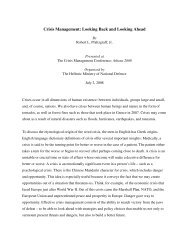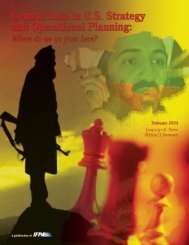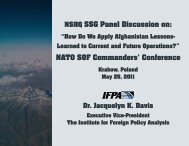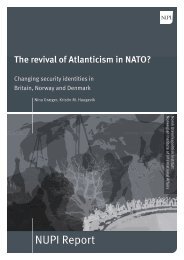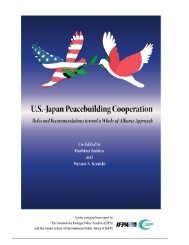March 2001 - Institute for Foreign Policy Analysis
March 2001 - Institute for Foreign Policy Analysis
March 2001 - Institute for Foreign Policy Analysis
Create successful ePaper yourself
Turn your PDF publications into a flip-book with our unique Google optimized e-Paper software.
Task Force-Kuwait (C/JTF-KU), at Camp Doha. This<br />
means that at any given time, there are approximately<br />
4,500 U.S. Army soldiers in Kuwait and a<br />
grand total of approximately 5,000 American personnel<br />
(including support staff and security) at Camp<br />
Doha. United States only has to fly in a few aircraft<br />
full of troops in a crisis to have a fully operational<br />
brigade on the ground in Kuwait. This is a significant<br />
change from 1990 when the first heavy brigade was<br />
not fully in place in Saudi Arabia until mid-September,<br />
a month and a half after the Iraqi invasion of<br />
Kuwait.<br />
In addition to these ground <strong>for</strong>ces, the United<br />
States Central Command (CENTCOM) also has<br />
approximately 160 combat aircraft in the region, at<br />
bases in Kuwait, Saudi Arabia, and Bahrain, as well<br />
as on a U.S. aircraft carrier normally positioned in<br />
the Persian Gulf. Most of these aircraft are involved<br />
in patrolling the southern no-fly zone over Iraq,<br />
but they would instantly switch to more intense<br />
combat operations if Iraq were to attempt to repeat<br />
its invasion of Kuwait. In addition, the U.S. has<br />
prepositioned equipment <strong>for</strong> another heavy brigade<br />
in Qatar and has the equipment <strong>for</strong> a Marine Air<br />
Ground Task Force (a Marine <strong>for</strong>ce of 17,500) on<br />
ships at Diego Garcia in the Indian Ocean. These<br />
ships can be in Persian Gulf waters in 5-7 days, and<br />
the Marines to man the equipment could be flown<br />
in from the United States in a matter of days.<br />
It is also important to note that Kuwait has<br />
spent a great deal of resources building up its own<br />
military capabilities, and while its <strong>for</strong>ces remain<br />
small, (approximately 11,000 troops) they are not<br />
insignificant. Kuwait has invested in new equipment<br />
(including U.S.-made M1A1 Abrams tanks<br />
and F/A-18 Hornets) and has worked closely with<br />
U.S. <strong>for</strong>ces to present an interoperable, coordinated<br />
defense <strong>for</strong>ce that provides not only a deterrent to<br />
any Iraqi provocation, but a <strong>for</strong>ce capable of defending<br />
Kuwaiti territory.<br />
Could it happen again<br />
In the near term, the probability of a repeat Iraqi<br />
invasion of Kuwait is low. Given the strong U.S.<br />
commitment to Kuwait and the existence of U.S.<br />
ground assets on Kuwaiti soil and air sites in the<br />
region, any attack on Kuwait would almost certainly<br />
be met with massive U.S. firepower. For a largescale<br />
attack, Iraq would need to mass enough armor,<br />
artillery and infantry along the border that the U.S.<br />
and regional allies would easily have the strategic<br />
warning necessary to mobilize troops and assets to<br />
deter or, if necessary, provide an adequate defense<br />
of Kuwait. However, Saddam Hussein has miscalculated<br />
U.S. resolve and capabilities in the past, and<br />
there are no guarantees that he will not repeat his<br />
Kuwait<br />
<strong>March</strong> <strong>2001</strong><br />
mistakes, or more importantly, that he is unwilling<br />
to embark on a new adventure given the lessons he<br />
has learned.<br />
One of the clear lessons that Saddam and adversaries<br />
of the U.S. around the world have seemingly<br />
digested is that asymmetric warfare is the best way<br />
of attacking the U.S. Given its massive conventional<br />
superiority, tackling the U.S. in a conventional war<br />
is an unattractive proposition. To this end, a future<br />
Iraqi attack on Kuwait may look very different from<br />
the 1990 invasion. With the U.S. deployments at<br />
Camp Doha, Ahmed Al Jaber and Ali Al Salem air<br />
bases, and the strategic Kuwait International Airport<br />
(necessary <strong>for</strong> landing 747s carrying U.S. troops),<br />
there are four critical strategic targets <strong>for</strong> Iraq to hit<br />
in any future invasion scenario.<br />
The specter of asymmetric warfare<br />
Asymmetric attacks on these facilities would likely<br />
involve the use of chemical or biological weapons.<br />
Iraq could do this with ballistic missiles or using<br />
special <strong>for</strong>ces and/or terrorist cells that infiltrated<br />
Kuwait. While UN resolutions currently restrict Iraq<br />
to missiles of no greater than 150 km in range, it<br />
is likely that Baghdad has kept some longer-range<br />
missiles hidden from UN inspectors and that it is currently<br />
rebuilding its capacity to produce longer-range<br />
missiles. A catastrophic short-term scenario could<br />
involve an extremely well coordinated chemical or<br />
biological attack on the above mentioned targets,<br />
Kuwait City, and other command and control assets.<br />
Such an attack could effectively eliminate the ability<br />
of the U.S. and Kuwaiti <strong>for</strong>ces to defend against<br />
a large-scale rapid Iraqi invasion that would soon<br />
follow, and hinder U.S. attempts (particularly if<br />
Kuwait International Airport is shut down) to introduce<br />
additional assets into the theater. U.S. airpower<br />
in the Gulf and elsewhere in the region would certainly<br />
be capable of bringing heavy <strong>for</strong>ce to bear<br />
on the advancing Iraqi military, but a determined<br />
offensive would likely be capable of occupying much<br />
of Kuwait.<br />
The use of chemical or biological weapons by Iraq<br />
would almost certainly create a worldwide outcry,<br />
and it would only be a matter of time be<strong>for</strong>e the U.S.<br />
was capable of launching a large-scale counteroffensive<br />
to liberate Kuwait <strong>for</strong> a second time. It is<br />
likely that Saddam Hussein is aware of this fact,<br />
making the above-mentioned scenario unlikely.<br />
Less grandiose, more troubling<br />
A much more likely and potentially worrisome scenario<br />
would involve a “lighting strike” offensive of<br />
Iraqi assets close to the border into the contested<br />
area of Northern Kuwait “taken” from Iraq after the<br />
Gulf War. This includes the disputed Ratga oil field,<br />
page<br />
19





